At its meeting last Tuesday, The County Planning Commission voted unanimously to renew the Sugar Hollow Agricultural and Forestal District, near White Hall.
The decision means that the district will remain underdeveloped for 10 years, in spite of local trends that claimed almost 8 percent of the Charlottesville area’s farmland between 2002 and 2007. The statewide average was about 6 percent.
Ag-Forest districts, as they are often called, result from voluntary agreements between landowners and local governments to protect natural areas and farmland from development. The Commission’s unanimous decision will now go the Board of Supervisors for review.
“Having so much land that people are making a statement, that people are deciding not to develop it, is a really good thing,” said Marcia Joseph, member at-large of the commission. Other members noted that the Sugar Hollow district is a particularly valuable region. Created in September 1989 with 2,546 acres, the district has roughly doubled in 20 years, to a contiguous 4,901 acres. For this growth, Calvin Morris, member of the Rivanna District, said the Ag-Forest committee and landowners are “to be commended.”
Most of the Sugar Hollow district falls in the watershed of the North Moorman’s River, which drains to the South Fork Rivanna River, and eventually to the area’s largest surface drinking water supply. Other portions of the district fall in the watershed of Beaver Creek Reservoir. Most of the district today is covered with forest, although there is some pasture.
Within the district, many parcels of land are already under conservation easements, which permanently protect farmland and wild areas from development through a similar agreement with a land trust or government entity. Absent an easement, land included in an Agricultural-Forestal District is protected for 10-year period, which entitles owners to tax benefits.
One such benefit is land-use valuation, in which a local government taxes a property owner based on the way his property is used—whether for agriculture, horticulture, forest or open space—rather than at market value.
“Being under the easement and being an Agricultural-Forestal District are equal qualifications for the open space tax rate,” said Scott Clark, a planner with the county, at the meeting. “Easements are typically more restrictive than districts, and are permanent. Once you’re in an easement, I don’t think being in a district is much more than being part of a community.”
In the previous 10-year period, by the September deadline, no landowners requested that their land be removed from the district. If a property within the district changes hands, it remains protected for the duration of the 10-year period.
However, those who live adjacent to these areas may request to have their land included in districts. In 20 of 24 Albemarle County districts, including Sugar Hollow, requests to add more land to districts are being considered and will be discussed by the Commission early next month.
C-VILLE welcomes news tips from readers. Send them to news@c-ville.com.





